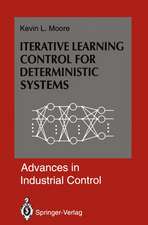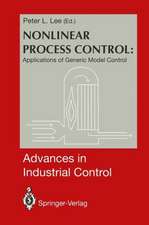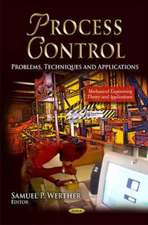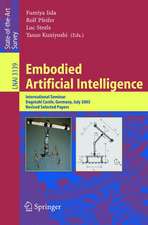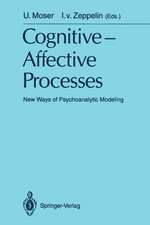The Playful Machine: Theoretical Foundation and Practical Realization of Self-Organizing Robots: Cognitive Systems Monographs, cartea 15
Autor Ralf Der, Georg Martius Cuvânt înainte de Rolf Pfeiferen Limba Engleză Hardback – 28 feb 2012
The book provides two levels of presentation. Students and scientific researchers interested in the field of robotics, self-organization and dynamical systems theory may be satisfied by the in-depth mathematical analysis of the principle, the bootstrapping scenarios, and the emerging behaviors. But the book additionally comes with a robotics simulator inviting also the non- scientific reader to simply enjoy the fabulous world of playful machines by performing the numerous experiments.
| Toate formatele și edițiile | Preț | Express |
|---|---|---|
| Paperback (1) | 643.34 lei 6-8 săpt. | |
| Springer Berlin, Heidelberg – 23 aug 2016 | 643.34 lei 6-8 săpt. | |
| Hardback (1) | 647.59 lei 3-5 săpt. | |
| Springer Berlin, Heidelberg – 28 feb 2012 | 647.59 lei 3-5 săpt. |
Din seria Cognitive Systems Monographs
- 20%
 Preț: 645.31 lei
Preț: 645.31 lei - 18%
 Preț: 957.62 lei
Preț: 957.62 lei - 15%
 Preț: 632.55 lei
Preț: 632.55 lei - 15%
 Preț: 643.99 lei
Preț: 643.99 lei - 20%
 Preț: 1447.17 lei
Preț: 1447.17 lei - 15%
 Preț: 629.73 lei
Preț: 629.73 lei - 15%
 Preț: 633.02 lei
Preț: 633.02 lei - 15%
 Preț: 639.90 lei
Preț: 639.90 lei - 20%
 Preț: 643.50 lei
Preț: 643.50 lei - 15%
 Preț: 640.55 lei
Preț: 640.55 lei - 15%
 Preț: 641.71 lei
Preț: 641.71 lei - 5%
 Preț: 1103.75 lei
Preț: 1103.75 lei - 15%
 Preț: 637.59 lei
Preț: 637.59 lei - 15%
 Preț: 648.24 lei
Preț: 648.24 lei - 20%
 Preț: 650.40 lei
Preț: 650.40 lei -
 Preț: 391.02 lei
Preț: 391.02 lei - 15%
 Preț: 643.48 lei
Preț: 643.48 lei - 20%
 Preț: 663.61 lei
Preț: 663.61 lei - 20%
 Preț: 652.54 lei
Preț: 652.54 lei - 20%
 Preț: 699.43 lei
Preț: 699.43 lei - 15%
 Preț: 640.88 lei
Preț: 640.88 lei - 20%
 Preț: 657.67 lei
Preț: 657.67 lei - 20%
 Preț: 1000.04 lei
Preț: 1000.04 lei - 20%
 Preț: 648.44 lei
Preț: 648.44 lei - 18%
 Preț: 886.92 lei
Preț: 886.92 lei - 20%
 Preț: 647.61 lei
Preț: 647.61 lei - 20%
 Preț: 651.09 lei
Preț: 651.09 lei - 20%
 Preț: 1161.71 lei
Preț: 1161.71 lei - 15%
 Preț: 642.68 lei
Preț: 642.68 lei - 20%
 Preț: 649.93 lei
Preț: 649.93 lei - 18%
 Preț: 944.19 lei
Preț: 944.19 lei
Preț: 647.59 lei
Preț vechi: 761.87 lei
-15% Nou
Puncte Express: 971
Preț estimativ în valută:
123.93€ • 134.57$ • 104.10£
123.93€ • 134.57$ • 104.10£
Carte disponibilă
Livrare economică 01-15 aprilie
Preluare comenzi: 021 569.72.76
Specificații
ISBN-13: 9783642202520
ISBN-10: 3642202527
Pagini: 356
Ilustrații: XX, 335 p.
Greutate: 0.62 kg
Ediția:2012
Editura: Springer Berlin, Heidelberg
Colecția Springer
Seria Cognitive Systems Monographs
Locul publicării:Berlin, Heidelberg, Germany
ISBN-10: 3642202527
Pagini: 356
Ilustrații: XX, 335 p.
Greutate: 0.62 kg
Ediția:2012
Editura: Springer Berlin, Heidelberg
Colecția Springer
Seria Cognitive Systems Monographs
Locul publicării:Berlin, Heidelberg, Germany
Public țintă
ResearchCuprins
1.Introduction.- 2.Self-Organization in Nature and Machines.- 3.The Sensorimotor Loop. - 4.Principles of Self-Regulation - Homeostasis . - 5.A General Approach to Self-Organization - Homeokinesis.- 6.From Fixed-Point Flows to Hysteresis Oscillators.- 7.Symmetries, Resonances, and Second Order Hysteresis.- 8.Low Dimensional Robotic Systems.- 9.Model Learning.- 10.High-Dimensional Robotic Systems.- 11.Facing the Unknown - Homeokinesis in a New Representation*.- 12.Guided Self-Organization - A First Realization.- 13.Channeling Self-Organization.- 14.Reward-Driven Self-Organization.- 15.Algorithmic Implementation.- 16.The LPZROBOTS Simulator.- 17.Discussion and Perspectives.- List of Figures.- List of Videos.- List of Experiments.- References.- Index.
Recenzii
From the reviews:
“Stressed on robots, the book presents the new tendencies of self-evaluation, self-organization and control of different type of technical systems, including the cognitive control theory as a new control language. The book is intended for students and researchers interested in self-organization on both the practical and theoretical level. … The book can be also a source for courses, which can be part of the academic program of electrical, control and computer science departments.” (Clementina Mladenova, Zentralblatt MATH, Vol. 1243, 2012)
“Stressed on robots, the book presents the new tendencies of self-evaluation, self-organization and control of different type of technical systems, including the cognitive control theory as a new control language. The book is intended for students and researchers interested in self-organization on both the practical and theoretical level. … The book can be also a source for courses, which can be part of the academic program of electrical, control and computer science departments.” (Clementina Mladenova, Zentralblatt MATH, Vol. 1243, 2012)
Textul de pe ultima copertă
Autonomous robots may become our closest companions in the near future. While the technology for physically building such machines is already available today, a problem lies in the generation of the behavior for such complex machines. Nature proposes a solution: young children and higher animals learn to master their complex brain-body systems by playing. Can this be an option for robots? How can a machine be playful? The book provides answers by developing a general principle---homeokinesis, the dynamical symbiosis between brain, body, and environment---that is shown to drive robots to self- determined, individual development in a playful and obviously embodiment- related way: a dog-like robot starts playing with a barrier, eventually jumping or climbing over it; a snakebot develops coiling and jumping modes; humanoids develop climbing behaviors when fallen into a pit, or engage in wrestling-like scenarios when encountering an opponent. The book also develops guided self-organization, a new method that helps to make the playful machines fit for fulfilling tasks in the real world.
The book provides two levels of presentation. Students and scientific researchers interested in the field of robotics, self-organization and dynamical systems theory may be satisfied by the in-depth mathematical analysis of the principle, the bootstrapping scenarios, and the emerging behaviors. But the book additionally comes with a robotics simulator inviting also the non- scientific reader to simply enjoy the fabulous world of playful machines by performing the numerous experiments.
The book provides two levels of presentation. Students and scientific researchers interested in the field of robotics, self-organization and dynamical systems theory may be satisfied by the in-depth mathematical analysis of the principle, the bootstrapping scenarios, and the emerging behaviors. But the book additionally comes with a robotics simulator inviting also the non- scientific reader to simply enjoy the fabulous world of playful machines by performing the numerous experiments.
Caracteristici
This work opens a new field of research The reader learns everything about the self-organization of behavior in robots that is known today A simulation software enables the reader to make immediately contact with the applications and provides the him with the tools to start developing its own variations and ideas quickly Includes supplementary material: sn.pub/extras





